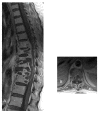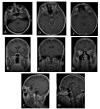Intraspinal and Intracranial Neurotuberculosis, Clinical and Imaging Characteristics and Outcomes in Hospitalized Patients: A Cohort Study (2000-2022)
- PMID: 37445568
- PMCID: PMC10342332
- DOI: 10.3390/jcm12134533
Intraspinal and Intracranial Neurotuberculosis, Clinical and Imaging Characteristics and Outcomes in Hospitalized Patients: A Cohort Study (2000-2022)
Abstract
Neurotuberculosis (neuroTB) is a devastating disease, and is difficult to diagnose. The aim of this study was to analyze the clinical and imaging characteristics, and outcomes of a retrospective cohort (2000-2022) of hospitalized patients diagnosed with intraspinal and intracranial neuroTB. This work was designed through clinical, laboratory and imaging findings. Variables included: demographic data, history of tuberculosis, neurological complications, comorbidities and outcomes. Morbi-mortality risk factors were identified by univariate analysis. The cohort included: 103 patients with intraspinal and 82 with intracranial neuroTB. During the study period, in-hospital mortality of 3% for intraspinal and 29.6% for intracranial neuroTB was estimated. Motor deficit was found in all patients with intraspinal neuroTB. Risk factors for the unfavorable outcome of patients with intraspinal neuroTB were: age ≥ 40 years, diabetes mellitus (DM), diagnostic delay, kyphosis and spondylodiscitis ≥ 3 levels of involvement. Among the patients with intracranial neuroTB, 79/82 (96.3%) had meningitis and 22 patients had HIV infection (10 of them died). Risk factors for mortality from intracranial neuroTB were: HIV infection, hydrocephalus, stroke, lymphopenia and disseminated and gastrointestinal TB. Patients with intraspinal neuroTB had a significant number of destroyed vertebrae that determined their neurological deficit status. The mortality burden in intracranial neuroTB was conditioned by HIV infection and renal transplantation patients.
Keywords: clinical characteristics; imaging; intracranial; intraspinal; neurotuberculosis; outcomes.
Conflict of interest statement
The authors declare no conflict of interest and they have read and agreed to the published version of the manuscript.
Figures





Similar articles
-
Intraspinal and intracranial Neurotuberculosis: A case report.J Clin Tuberc Other Mycobact Dis. 2025 May 2;40:100532. doi: 10.1016/j.jctube.2025.100532. eCollection 2025 Aug. J Clin Tuberc Other Mycobact Dis. 2025. PMID: 40485837 Free PMC article.
-
Clinical Features, Treatment, and Prognostic Factors of 56 Intracranial and Intraspinal Clear Cell Meningiomas.World Neurosurg. 2018 Mar;111:e880-e887. doi: 10.1016/j.wneu.2017.12.173. Epub 2018 Jan 8. World Neurosurg. 2018. PMID: 29325940
-
Changing Clinicoradiologic Spectrum of Intracranial Neurotuberculosis in Children: A Cross-sectional Study.J Child Neurol. 2020 Nov;35(13):879-888. doi: 10.1177/0883073820938594. Epub 2020 Jul 17. J Child Neurol. 2020. PMID: 32677487
-
Magnetic resonance imaging spectrum of intracranial tubercular lesions: one disease, many faces.Pol J Radiol. 2018 Dec 29;83:e524-e535. doi: 10.5114/pjr.2018.81408. eCollection 2018. Pol J Radiol. 2018. PMID: 30800191 Free PMC article. Review.
-
Extrapulmonary tuberculosis: tuberculous meningitis new developments.Eur Rev Med Pharmacol Sci. 2011 Apr;15(4):365-86. Eur Rev Med Pharmacol Sci. 2011. PMID: 21608431 Review.
Cited by
-
Tuberculosis menace: a case report of disseminated tuberculosis presenting as tubercular meningitis and long-segment cervical tuberculous myelitis in a 32-year-old man from rural India.Front Med (Lausanne). 2025 Jan 30;12:1507511. doi: 10.3389/fmed.2025.1507511. eCollection 2025. Front Med (Lausanne). 2025. PMID: 39950123 Free PMC article.
-
Intraspinal and intracranial Neurotuberculosis: A case report.J Clin Tuberc Other Mycobact Dis. 2025 May 2;40:100532. doi: 10.1016/j.jctube.2025.100532. eCollection 2025 Aug. J Clin Tuberc Other Mycobact Dis. 2025. PMID: 40485837 Free PMC article.
References
-
- World Health Organization Tuberculosis Profile: WHO Global. 2021. [(accessed on 28 May 2023)]. Available online: https://worldhealthorg.shinyapps.io/tb_profiles/?_inputs_&lan=%22ES%22&e....
-
- CENAPRECE Casos Nuevos de Tuberculosis Todas Formas Estados Unidos Mexicanos 1990–2016. [(accessed on 28 May 2022)]. Available online: http://www.cenaprece.salud.gob.mx/programas/interior/micobacteriosis/des....
LinkOut - more resources
Full Text Sources

